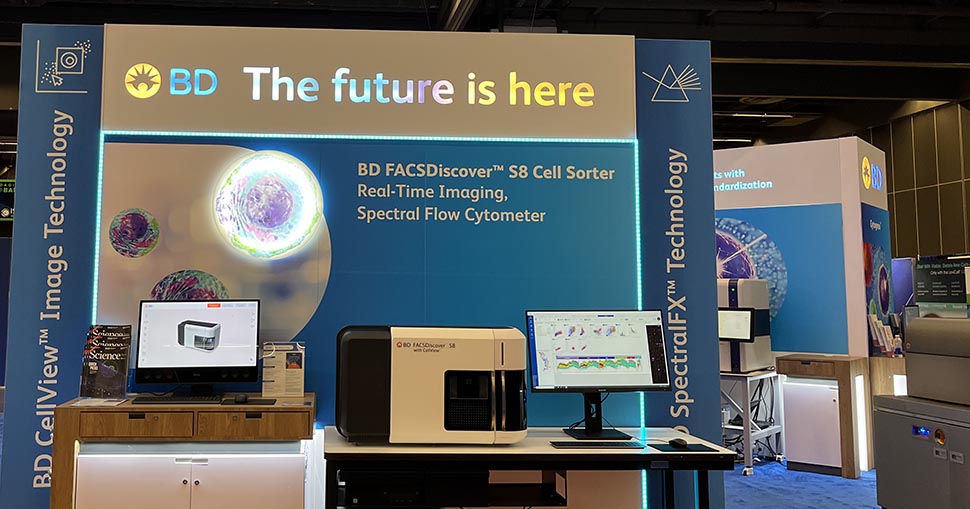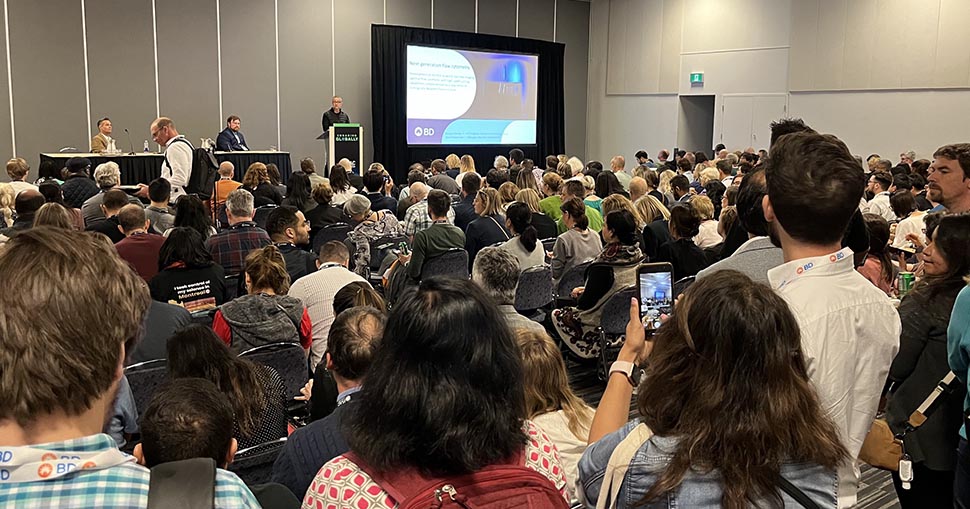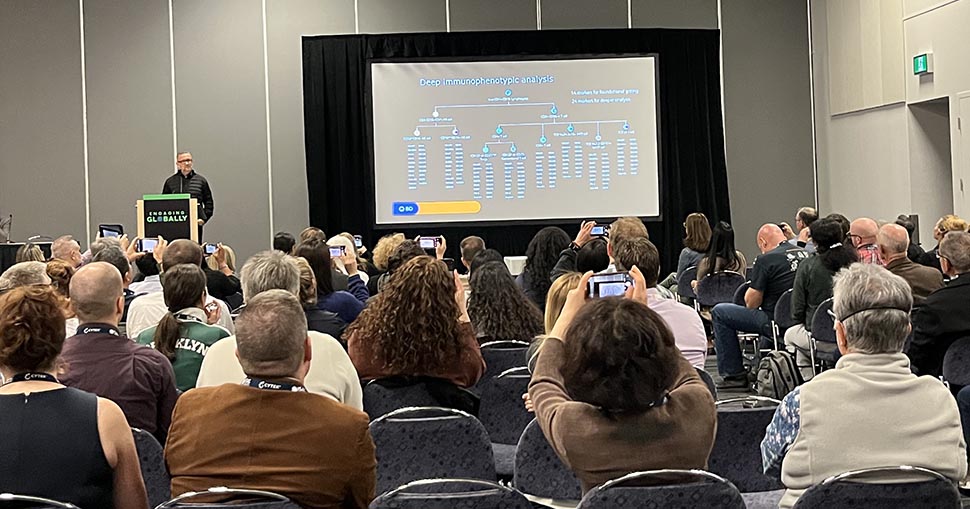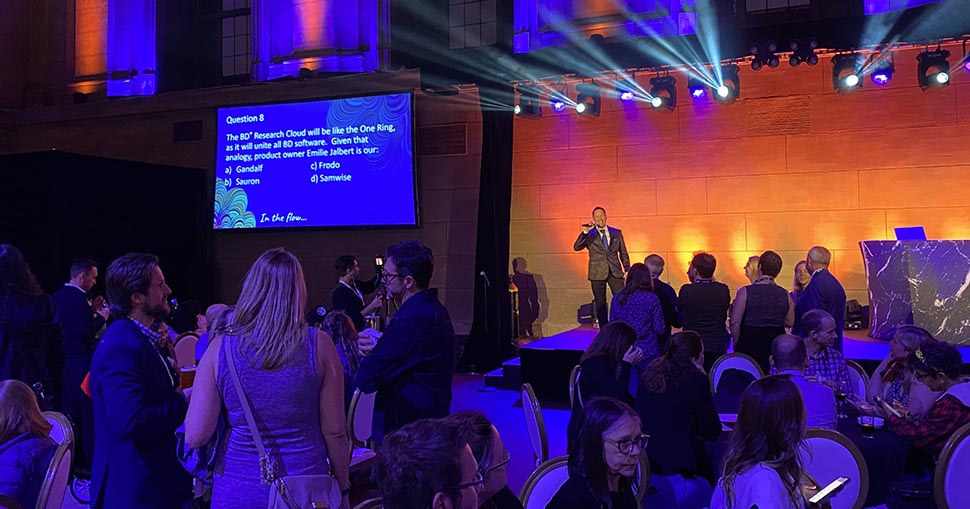The First Real-Time Imaging Spectral Flow Cytometer Shines at CYTO 2023
Imaging cytometry. Artificial intelligence. Quality control. CYTO 2023 exceeded expectations by diving deep into scientific innovation. Set in the cultural capital of Canada—Montréal, Québec—the conference attracted more than 13,000 people affiliated with various types of institutions from around the world. Notable this year was the increased participation of pharmaceutical and biotechnology companies, thirsty for high-throughput, high-parameter analysis and automation capabilities. But, true to its reputation, this year’s meeting catered to academics, curious about the next innovations in flow cytometry and eager to see how they can push the limits of science. Attendees were in for a feast, with exposure to advances in instrumentation and dye chemistry and opportunities to interact with the actual R&D scientists who developed some of the new technologies and gather some tips and best practices. BD Biosciences, a proud Platinum Sponsor of the event, led the innovation showcase and stole the show with their newest innovation: a combination of real-time imaging and high-speed spectral cell sorting.
Three Winning Themes of CYTO2023: Imaging Cytometry, Use of Artificial Intelligence (AI) and Quality Control
Imaging Cytometry: The Latest trend in Cell Analysis
Each day of the conference had at least one session on imaging cytometry. An array of imaging techniques and approaches—including real-time imaging, multiplexed antibody-based imaging, multiplexed tissue imaging, 3-D imaging, multiphoton imaging, and infra-red chemical imaging—were discussed.
AI and Flow Cytometry: Newer Possibilities
As is the trend everywhere, the all-pervasive influence of AI was palpable at CYTO. Topics such as how AI can automate flow cytometry to help determine which cells get sorted and how it can be used in flow cytometry data analysis permeated several discussion sessions. Deep learning models, information management and cloud computing and storage were a few of the other topics covered in these sessions.
Focus on Quality Control for Flow Cytometry
Another perceptible common thread between different presentations and workshops was recognizing issues with the quality of flow cytometry data. Concerns about implicit bias, proper communication of risk assessment and the absence of defined best practices were examined at length. In the context of spectral flow cytometry, discussions on the use of proper quality controls (QC) and the need for next-generation QC for spectral unmixing dominated the sessions.
Booth #415—The Most Popular Booth at CYTO
BD Biosciences made a splash at the conference with its sensational new product announcements and novel solutions for problems that the flow cytometry community has been facing for decades. There was no dull moment in booth #415, which brimmed with activity and visitors from the start to the end of the conference. With hundreds of enthralled scientists interested in learning about the BD FACSDiscover™ S8 Cell Sorter—the first-to-world real-time imaging spectral flow cytometer—the BD team was equally eager to entertain their scientific curiosity. In addition to the official launch of the BD FACSDiscover™ S8 Cell Sorter at the conference, BD showcased several next-generation flow cytometry reagents such as the laser-specific BD Horizon RealBlue™ and BD Horizon RealYellow™ Reagents. This family of flow cytometry reagents are specially engineered to deliver reduced spillover to optimize resolution when used with other fluorochromes. BD also introduced the recent addition to its single-cell multiomics instrument portfolio—the BD Rhapsody™ HT Xpress System for high-throughput analysis of single cells.

BD Tutorials—A Packed House
BD Biosciences presented two tutorials at the conference. The first offered a unique experience to the audience with the R&D scientists who envisioned and developed the breakthrough BD CellView™ Image Technology and BD SpectralFX™ Technology discussing how they can overcome the limitations of camera-based imaging systems, such as low speed of imaging, for flow cytometry. They showcased how these new technologies were integrated in a 5-laser, 78-detector spectral flow cytometer. They also explained how the new family of strategically designed BD Horizon RealBlue™ and BD Horizon RealYellow™ Reagents complements the technology to minimize current challenges posed by the limited availability of unique, laser-specific fluorochromes. The high turnout for this tutorial was a testimonial to the gap that these technologies are filling. Until this point, the ability to view and analyze images of cells in real time and follow through with full-spectrum high-speed cell sorting has remained a pipedream for many scientists. The BD FACSDiscover™ S8 Cell Sorter expands the power of cell analysis and sorting to new dimensions by combining spectral flow cytometry with real-time spatial and morphological insights—empowering scientists to address previously impossible-to-answer questions.

The second tutorial from BD Biosciences addressed the problems associated with panel design. The tutorial covered aspects of using a high-parameter human NK and T cell spectral flow cytometry panel for an in-depth investigation of immune cell variability across healthy donors. Robert Balderas, VP of market development, walked the audience through strategies for designing broad and deep immunophenotyping panels and striking the balance between panel size and biological resolution.

Fun with Flow Cytometry—Playing Flow Cytometry Trivia
What is Shapiro’s 0th Law of Cytometry?
Which Laser Excites APC the Least?
In What Kind of Distribution Are the Mean, Median and Mode Equal?
For the flow cytometry aficionados, solving this kind of trivia was one way of having fun at the conference. Scientists not only got to dig into their flow cytometry knowledge in general but even got to show off their intimate familiarity with features like which clustering algorithms are available as FlowJo™ Software plugins and the names of the newsletter and blog featuring details of the software. Their enthusiastic participation was apparent in the fact that the BD team ran out of pens during the trivia event, not able to cater to all four hundred attendees who wanted to participate!

The Prestigious Joseph T. Trotter Leader in Cytometry Technology Award
BD Biosciences is the proud sponsor of this annual award. This year it was awarded to Dr. Bruce Bagwell for his enormous contribution towards high-dimensional modeling for flow cytometry and for developing algorithms for sorting cell populations.
It’s Poster Time
BD Biosciences presented several technical posters showcasing the use of the new technology that was unveiled at the conference. Posters describing topics from high-throughput single-cell whole transcriptome analysis of various blood cell types to deconvolution of mitochondrial morphology in T cells using imaging flow cytometry and the use of image-derived features to identify and exclude non-singlet events in flow cytometry sort workflows were presented.
All posters presented at the conferences can be downloaded at our CYTO2023 event page.
